Thirteenth Mayors Conference
Nuuk Challenges Global Community
Global Battle Against Climate Change Urged
Under the theme “Climatic Changes in the Arctic,” the thirteenth biennial conference of the World Winter Cities Association for Mayors (WWCAM) was held successfully from 18 to 20 January 2008 in Nuuk, Greenland. Topics and discussions related to global warming dominated the three-day conference.
The Mayors Conference was attended by mayors and representatives of 22 cities from eight countries.
Mayors Conference
City representatives engaged in active exchanges of ideas and opinions related to measures against global warming. With the pressing threat of global warming, it was clear that participant cities are embracing and implementing measures with a heightened sense of concern and awareness, and the Mayors Conference played host to a succession of informative reports on various leading-edge initiatives and projects.
Winter Cities Forum
At the Winter Cities Forum in Nuuk, thirteen experts from Greenland, Denmark, Norway, the U.S., and Japan discussed topics related to the environment, including youth and the environment, energy conservation, and new forms of energy.
Winter Expo
Member city corporations and organizations displayed winter- and snow-related technologies and products at the Winter Expo. Greenland corporations occupied most of the Expo’s forty booths. Some displayed products related to climate change, and others provided tourism information or introduced traditional Greenland culture, which attracted the attention of visitors.
Nuuk Declaration
On the final day of the conference, the WWCAM unanimously approved the Nuuk Declaration, which includes a recognition of “the duty that winter cities have to take a leading role in global society…”, and a pledge “to make every effort to tackle the problem of global warming.”
Greetings from Nuuk
About a month and a half has passed since the successful thirteenth Mayors Conference. Not only was this my first time as a participating member of the WWCAM network, it was also the first time Nuuk hosted the conference which we had all been looking forward to for a very long time.
The conference theme, “Climatic Changes in the Arctic,” was most relevant. Here we can virtually watch the glaciers melt, and fishers and hunters find it ever more difficult to maintain their subsistence. Yet this winter, we’ve had more cold and snow than ever. For sure, there’s something about the climate.
Many of you visited Greenland for the first time, and my impression is that you had a great time. Not only is Nuuk beautifully located, meeting the people here makes the visit worthwhile. Greenlanders are known for their warm hospitality, and Nuuk’s locals were so exited about meeting WWCAM members.
I am happy that we managed to sign the Nuuk Declaration 2008, which has committed all of us politicians to work towards bringing down CO2 emissions and making the world a better place for the next generation. I am looking forward to my ongoing task of living up to the Nuuk Declaration 2008.
Nikolaj Heinrich, Mayor of Nuuk
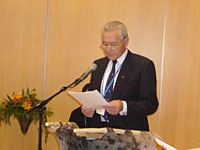
Nikolaj Heinrich, mayor of Nuuk, Greenland addresses the thirteenth biennial Mayors Conference.
The Nuuk Declaration 2008
The following is an excerpt from the Nuuk Declaration 2008. The Declaration also includes a pledge that WWCAM members “maintain an active awareness of movements on the national level and make every effort to realize” a number of objectives for taking a leading role in global society.
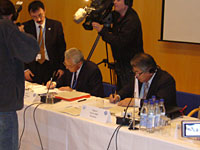
Mayors Nikolaj Heinrich of Nuuk (left) and Ueda Fumio of Sapporo (right) sign the Nuuk Declaration.
Nuuk Declaration 2008
There is little dispute that global climate change is one of the most serious threats to the world’s people. Scientists across the globe have documented that climate change is rapidly increasing, due largely to activities by industrialized society. According to the report published by the Intergovernmental Panel on Climate Change (IPCC) in November of 2007, if the amount of greenhouse gases emitted globally continues to increase over the next 20 to 30 years, one can predict as a result that warming in the 21st century will occur on a scale greater than that which occurred during the 20th century.
Communities of the North, especially those in the Arctic and Greenland, find themselves on “ground zero” of the effects of global climate change. The increase in temperatures during the winter season is having a significant impact on the daily life and traditional cultures of people of the North. As members of the World Winter Cities Association for Mayors and officials of the local governments created by and for these residents, we recognize our collective obligation to send a global message underscoring the severity of global warming.
Sharing the climatic characteristics of cold weather and heavy snowfalls, winter cities consume a great deal of energy for winter heating, snow removal, and snow disposal. Given our contribution to increasing CO2 and other greenhouse gas emissions, we winter cities must recognize the inconsistency evident as we ourselves contribute to global warming. We participant cities recognize the duty that winter cities have to take a leading role in global society. Therefore, we hereby pledge to utilize the collective wisdom of the World Winter Cities Association for Mayors to make every effort to tackle the problem of global warming.
On the international level, considerations of a “post-Kyoto Protocol” framework for implementation starting in 2013 dominated discussions at the December 2007th session of the Conference of Parties to the United Nations Framework Convention on Climate Change (COP13), and the issues of climate change and the environment are planned as main themes for the 2008 G8 Hokkaido Toyako Summit. In our position as local government bodies, we pledge to maintain an active awareness of movements on the national level and make every effort to realize the following objectives as we strive to take a leading role in global society:
1. Work towards establishing a Member City framework for global warming countermeasures (goals for reduced CO2 and other greenhouse gas emissions, etc.) based on the precedents set by advanced Member Cities.
2. Take the initiative as winter city governmental bodies to pursue measures for energy conservation and environmental conservation, and actively embrace our guiding role by urging and encouraging local residents in their actions and measures.
3. Lessen our reliance on fossil fuels by actively pursuing the use of such renewable energy sources as biomass and natural energy.
4. Work to expand the network of winter cities engaged in dealing with global environmental issues by having Member Cities share information regarding countermeasures for global warming with other cities in their region.
5. Monitor the advancements made with regard to the aforementioned points through the current Subcommittee on Winter Cities Environmental Issues and the Subcommittee planned for establishment based on the proposal made by the city of Anchorage.
2008 WWCAM Conference Participants
WWCAM Member Cities
Changchun, Harbin, Jiamusi, Jixi, Shenyang (China); Nuuk (Greenland); Sapporo (Japan); Taebaek (Korea); Kaunas (Lithuania); Tromso (Norway); Anchorage (United States)
Non-Member Cities
Aalborg (Denmark); Aasiaat, Ittoqqortoormiit, Ivittuut, Nanortalik, Paamiut, Qaqortoq, Sisimiut, Upernavik, Uummannaq (Greenland); Hammerfest (Norway)
Subcommittee on Winter Environmental Issues
The Subcommittee on Winter Environmental Issues, which was established in 2006, presented an interim report of the Subcommittee activities at the Mayors Conference in Nuuk. Major points of the report include-
・Environmental concerns are common to all the member cities of the WWCAM;
・Many cities are keenly aware of abnormal weather caused by climate change. Additionally, many cities conduct educational activities for their residents, indicating that local governments are seriously acknowledging global warming.
・Member cities have been steadily dealing with countermeasures, including the development of plans to counteract global warming.
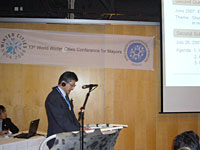
An interim report of the Subcommittee on Winter Environmental Issues is presented at Nuuk.
Youth Against Global Warming
Broad-based citizen support is crucial to ensuring the success of measures for mitigating global warming. It is particularly important that youth groups are involved; they represent the future of our planet. The city of Tromso, Norway gives particular attention to this segment of the population, and the city’s report on this important topic, “Working with Youth to Fight Global Warming,” was presented at the Mayors Conference. Tromso reported on the Nordic Youth Film Festival, a short film event that encourages youth involvement and participation in current issues. The theme for the 2007 Festival was global warming, and a humorous film on food in the fridge proved popular among Mayors Conference participants. Through the creation of short films, youths have gained a greater appreciation for the issue of global warming, and thereby realizing one of the goals of the Festival.
The city of Anchorage, US reported on Alaska Youth for Environmental Action, a program that includes hands-on educational experiments and measures for energy conservation. The program emphasizes the importance of children taking the initiative for action.
Sapporo presented on “Food Recycling,” a school lunch program that instills in children an appreciation for the importance of the environment.
Conference chair and mayor of Nuuk Nikolaj Heinrich made a strong impression on participants at the conference with his comments at the closing ceremony. “The future of our planet belongs to the children, and it is our responsibility to preserve that future on their behalf,” the mayor noted, once again highlighting the importance of actively promoting the participation of youth in environmental issues.
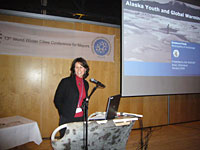
Suzanne Fleek-Green reported on Alaska Youth and Global Warming.
What is Food Recycling?
A program begun by the city of Sapporo in 2006, “Food Recycling” entails the composting of school lunch leftovers, with the resulting fertilizer supplied to farms for use in growing ingredients for future school lunches. The program has also proved effective as an educational tool for promoting environmental awareness among children.
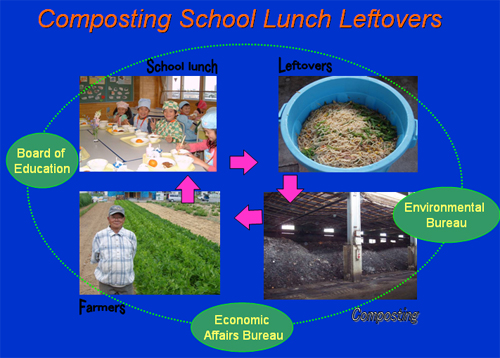
Energy Conservation on Winter City Agendas
The heavy snowfalls and cold temperatures of winter cities make them consumers of large amounts of energy for heating and snow removal, and as a result they contribute to global warming. Many winter cities are striving to reduce this negative impact on the environment, and presentations at the Mayors Conference were made by cities that are dealing with energy-related issues in a variety of ways.
Sapporo, Japan reported at the Winter Cities Forum on how snow is put in storage, and the cold energy is used in summer to air condition office buildings. The idea that their heavy snowfalls contribute to energy conservation may help Sapporo residents feel better about the unpleasant chore of snow shoveling in winter. Sapporo’s presentation attracted keen attention among conference participants.
Anchorage, Alaska reported that city traffic lights have been replaced with energy-efficient Light Emitting Diode (LED) lights. Although an initial investment is necessary to make the change to LEDs, the cost is recovered by energy savings. Compared with conventional lights, LEDs consume a smaller amount of electricity and emit less heat radiation, consequently contributing to a reduction of CO2.
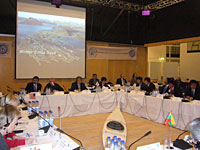
WWCAM members confer in Nuuk.






